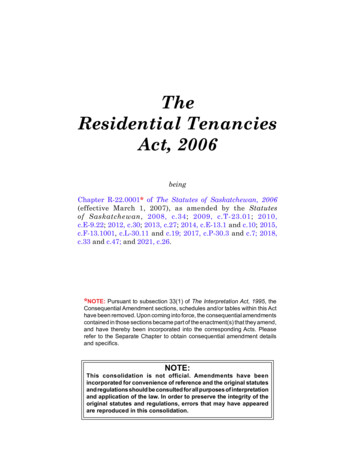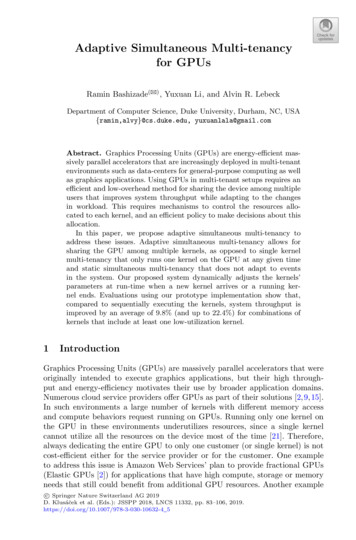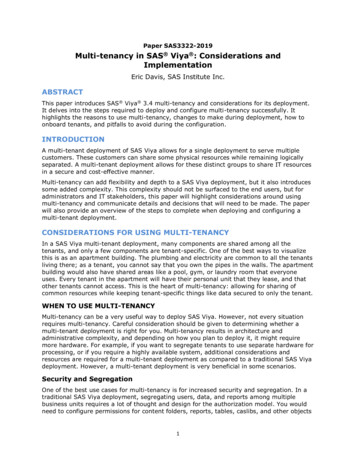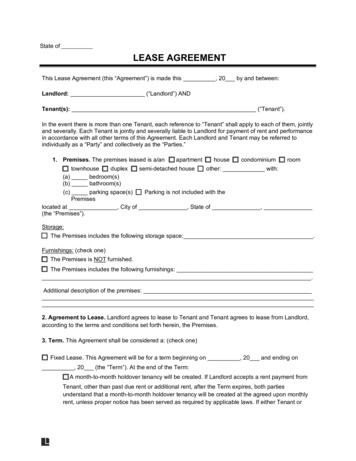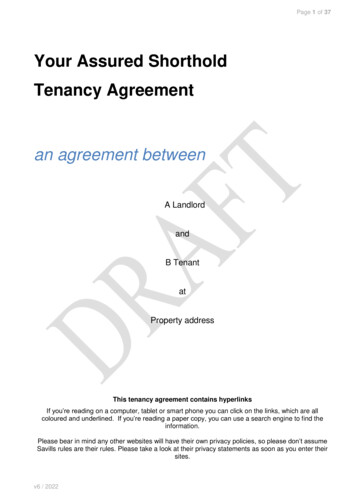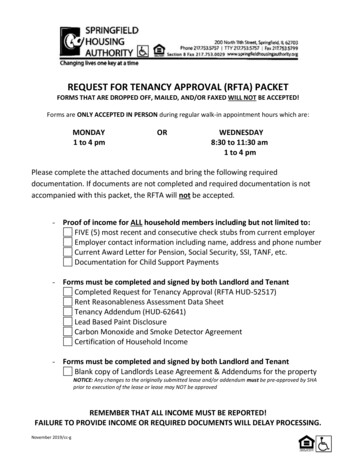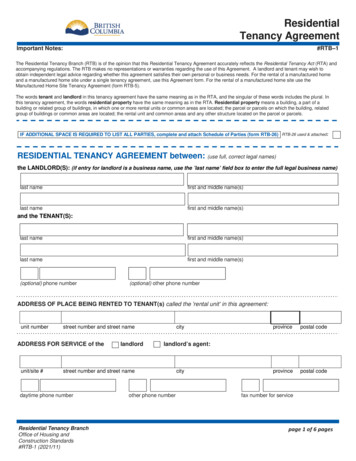
Transcription
ResidentialTenancy AgreementImportant Notes:#RTB–1The Residential Tenancy Branch (RTB) is of the opinion that this Residential Tenancy Agreement accurately reflects the Residential Tenancy Act (RTA) andaccompanying regulations. The RTB makes no representations or warranties regarding the use of this Agreement. A landlord and tenant may wish toobtain independent legal advice regarding whether this agreement satisfies their own personal or business needs. For the rental of a manufactured homeand a manufactured home site under a single tenancy agreement, use this Agreement form. For the rental of a manufactured home site use theManufactured Home Site Tenancy Agreement (form RTB-5).The words tenant and landlord in this tenancy agreement have the same meaning as in the RTA, and the singular of these words includes the plural. Inthis tenancy agreement, the words residential property have the same meaning as in the RTA. Residential property means a building, a part of abuilding or related group of buildings, in which one or more rental units or common areas are located; the parcel or parcels on which the building, relatedgroup of buildings or common areas are located; the rental unit and common areas and any other structure located on the parcel or parcels.IF ADDITIONAL SPACE IS REQUIRED TO LIST ALL PARTIES, complete and attach Schedule of Parties (form RTB-26) RTB-26 used & attached:RESIDENTIAL TENANCY AGREEMENT between: (use full, correct legal names)the LANDLORD(S): (if entry for landlord is a business name, use the ’last name’ field box to enter the full legal business name)last namefirst and middle name(s)last namefirst and middle name(s)and the TENANT(S):last namefirst and middle name(s)last namefirst and middle name(s)(optional) phone number(optional) other phone numberADDRESS OF PLACE BEING RENTED TO TENANT(s) called the 'rental unit' in this agreement:unit numberstreet number and street nameADDRESS FOR SERVICE of theunit/site #landlordcityResidential Tenancy BranchOffice of Housing andConstruction Standards#RTB-1 (2021/11)postal codeprovincepostal codelandlord’s agent:street number and street namedaytime phone numberprovinceother phone numbercityfax number for servicepage 1 of 6 pages
1. APPLICATION OF THE RESIDENTIAL TENANCY ACT1) The terms of this tenancy agreement and any changes or additions to the terms may not contradict or change anyright or obligation under the Residential Tenancy Act or a regulation made under that Act, or any standard terms. Ifa term of this tenancy agreement does contradict or change such a right, obligation or standard term, the term ofthe tenancy agreement is void.2) Any change or addition to this tenancy agreement must be agreed to in writing and initialed by both the landlordand the tenant. If a change is not agreed to in writing, is not initialed by both the landlord and the tenant or isunconscionable, it is not enforceable.3) The requirement for agreement under subsection (2) does not apply to:a) a rent increase given in accordance with the Residential Tenancy Act,b) a withdrawal of, or a restriction on, a service or facility in accordance with the Residential Tenancy Act, orc) a term in respect of which a landlord or tenant has obtained an arbitrator's order that the agreement of the otheris not required.2. BEGINNING AND TERM OF THE AGREEMENT (please fill in the dates and times in the spaces provided)This tenancy created by this agreement starts on:dayCheckA, B or CmonthyearA) and continues on a month-to-month basis until ended in accordance with the Act.B) and continues on another periodic basis, as specified below, until ended in accordance with the Act.weeklybi-weeklyother:C) and is for a fixed term tenancy ending onIF YOU CHOOSE C, CHECK AND COMPLETE D OR ECheckD or EdayyearmonthD) At the end of this time, the tenancy will continue on a month-to-month basis, or another fixed length oftime, unless the tenant gives notice to end tenancy at least one clear month before the end of the term.E) At the end of this time, the tenancy is ended and the tenant must vacate the rental unit.This requirement is only permitted in circumstances prescribed under section 13.1 of theResidential Tenancy Regulation, or if this is a sublease agreement as defined in the Act.Reason tenant must vacate (required):Residential Tenancy Regulation section number (if applicable):Landlord’sInitials If you choose E, both the landlord and tenant must initial hereTenant’sInitialsThe tenant must move out on or before the last day of the tenancy.3. RENT (please fill in the information in the spaces provided)a) Payment of Rent:The tenant will pay the rent of each(check one)dayweekmonth to the landlord onthe first day of the rental period which falls on the (due date, e.g., 1st, 2nd, 3rd, . 31st)day of each(check one)dayweekmonth subject to rent increases given in accordance with the RTA.The tenant must pay the rent on time. If the rent is late, the landlord may issue a Notice to End Tenancy for UnpaidRent (form RTB-30) to the tenant, which may take effect not earlier than 10 days after the date the notice is given.b) What is included in the rent: (Check only those that are included and provide additional information, if needed.)The landlord must not terminate, or restrict a service or facility that is essential to the tenant’s use of the rental unitas living accommodation, or that is a material term of the tenancy agreement.WaterNatural gasGarbage collectionRefrigeratorCarpetsCablevisionSewage disposalRecycling servicesDishwasherParking forElectricitySnow removalKitchen scrap collectionStove and ovenOther:InternetStorageLaundry (coin-op)Window coveringsOther:HeatRecreation facilitiesFree laundryFurnitureOther:vehiclesAdditional information:page 2 of 6 pages
4. SECURITY DEPOSIT AND PET DAMAGE DEPOSITA. Security DepositsThe tenant is required to pay a security deposit of bydaymonthyearB. Pet Damage Depositnot applicableThe tenant is required to pay a pet damage deposit of bydaymonthyear1) The landlord agreesa) that the security deposit and pet damage deposit must each not exceed one half of the monthly rent payablefor the residential property,b) to keep the security deposit and pet damage deposit during the tenancy and pay interest on it in accordancewith the regulation, andc) to repay the security deposit and pet damage deposit and interest to the tenant within 15 days of the end ofthe tenancy agreement, unlessi) the tenant agrees in writing to allow the landlord to keep an amount as payment for unpaid rentor damage, orii) the landlord applies for dispute resolution under the Residential Tenancy Act within 15 days of the endof the tenancy agreement to claim some or all of the security deposit or pet damage deposit.2) The 15 day period starts on the later ofa) the date the tenancy ends, orb) the date the landlord receives the tenant's forwarding address in writing.3) If a landlord does not comply with subsection (1)(c), the landlorda) may not make a claim against the security deposit or pet damage deposit, andb) must pay the tenant double the amount of the security deposit, pet damage deposit, or both.4) The tenant may agree to use the security deposit and interest as rent only if the landlord gives written consent.5. PETSAny term in this tenancy agreement that prohibits, orrestricts the size of, a pet or that governs the tenant'sobligations regarding the keeping of a pet on theresidential property is subject to the rights andrestrictions under the Guide Dog and Service Dog Act.6. CONDITION INSPECTIONS1) In accordance with sections 23 and 35 of the Act[condition inspections] and Part 3 of the regulation[condition inspections], the landlord and tenant mustinspect the condition of the rental unit togethera) when the tenant is entitled to possession,b) when the tenant starts keeping a pet during thetenancy, if a condition inspection was notcompleted at the start of the tenancy, andc) at the end of the tenancy.2) The landlord and tenant may agree on a differentday for the condition inspection.3) The right of the tenant or the landlord to claimagainst a security deposit or a pet damage deposit,or both, for damage to residential property isextinguished if that party does not comply withsection 24 and 36 of the Residential Tenancy Act[consequences if report requirements not met].7. PAYMENT OF RENT1) The tenant must pay the rent on time, unless thetenant is permitted under the Act to deduct fromthe rent. If the rent is unpaid, the landlord mayissue a 10 Day Notice to End Tenancy (formRTB-30) to the tenant, which may take effect notearlier than 10 days after the date the tenantreceives the notice.2) The landlord must not take away or make the tenant pay extra for a service or facility that is alreadyincluded in the rent, unless a reduction is madeunder section 27 (2) of the Act.3) The landlord must give the tenant a receipt for rentpaid in cash.4) The landlord must return to the tenant on or beforethe last day of the tenancy any post-dated chequesfor rent that remain in the possession of the landlord. If the landlord does not have a forwardingaddress for the tenant and the tenant has vacatedthe premises without notice to the landlord, thelandlord must forward any post-dated cheques forrent to the tenant when the tenant provides a forwarding address in writing.page 3 of 6 pages
8. RENT INCREASE1) Once a year the landlord may increase the rent forthe existing tenant. The landlord may only increasethe rent 12 months after the date that the existingrent was established with the tenant or 12 monthsafter the date of the last legal rent increase for thetenant, even if there is a new landlord or a newtenant by way of an assignment. The landlord mustuse the approved Notice of Rent Increase formavailable from any Residential Tenancy Branchoffice or Service BC office.2) A landlord must give a tenant three whole monthsnotice, in writing, of a rent increase. [For example,if the rent is due on the 1st of the month and thetenant is given notice any time in January, includingJanuary 1st, there must be three whole monthsbefore the increase begins. In this example, themonths are February, March and April, so theincrease would begin on May 1st.]3) The landlord may increase the rent only in theamount set out by the regulation. If the tenantthinks the rent increase is more than is allowed bythe regulation, the tenant may talk to the landlord orcontact the Residential Tenancy Branch forassistance.4) Either the landlord or the tenant may obtain thepercentage amount prescribed for a rent increasefrom the Residential Tenancy Branch.9. ASSIGN OR SUBLET1) The tenant may assign or sublet the rental unit toanother person with the written consent of thelandlord. If this tenancy agreement is for a fixedlength and has 6 months or more remaining in theterm, the landlord must not unreasonably withholdconsent. Under an assignment a new tenant mustassume all of the rights and obligations under theexisting tenancy agreement, at the same rent. Thelandlord must not charge a fee or receive abenefit, directly or indirectly, for giving thisconsent.2) If a landlord unreasonably withholds consent toassign or sublet or charges a fee, the tenant mayapply for dispute resolution under the ResidentialTenancy Act.10. REPAIRS1) Landlord's obligations:a) The landlord must provide and maintain theresidential property in a reasonable state ofdecoration and repair, suitable for occupationby a tenant. The landlord must comply withhealth, safety and housing standards requiredby law.b) If the landlord is required to make a repair tocomply with the above obligations, the tenantmay discuss it with the landlord. If the landlordrefuses to make the repair, the tenant mayseek an arbitrator's order under theResidential Tenancy Act for the completionand costs of the repair.2) Tenant's obligations:a) The tenant must maintain reasonable health,cleanliness and sanitary standards throughoutthe rental unit and the other residentialproperty to which the tenant has access. Thetenant must take the necessary steps to repairdamage to the residential property caused bythe actions or neglect of the tenant or a personpermitted on the residential property by thetenant. The tenant is not responsible forreasonable wear and tear to the residentialproperty.b) If the tenant does not comply with the aboveobligations within a reasonable time, thelandlord may discuss the matter with thetenant and may seek a monetary orderthrough dispute resolution under theResidential Tenancy Act for the cost of repairs,serve a notice to end a tenancy, or both.3) Emergency Repairs:a) The landlord must post and maintain in aconspicuous place on the residential property,or give to the tenant in writing, the name andtelephone number of the designated contactperson for emergency repairs.b) If emergency repairs are required, the tenantmust make at least two attempts to telephonethe designated contact person, and then givethe landlord reasonable time to complete therepairs.c) If the emergency repairs are still required, thetenant may undertake the repairs, and claimreimbursement from the landlord, provided astatement of account and receipts are given tothe landlord. If the landlord does not reimbursethe tenant as required, the tenant may deductthe cost from rent. The landlord may take overcompletion of the emergency repairs at anytime.d) Emergency repairs must be urgent andnecessary for the health and safety of personsor preservation or use of the residentialproperty and are limited to repairingi) major leaks in pipes or the roof,ii) damaged or blocked water or sewerpipes or plumbing fixtures,iii) the primary heating system,iv) damaged or defective locks that giveaccess to a rental unit, orv) the electrical systems.11. OCCUPANTS AND GUESTS1) The landlord must not stop the tenant from havingguests under reasonable circumstances in therental unitpage 4 of 6 pages
2) The landlord must not impose restrictions onguests and must not require or accept any extracharge for daytime visits or overnightaccommodation of guests.2.1) Despite subsection (2) of this section but subject tosection 27 on the Act [terminating or restrictingservices or facilities], the landlord may imposereasonable restrictions on guests' use of commonareas of the residential property.3) If the number of occupants in the rental unit isunreasonable, the landlord may discuss the issuewith the tenant and may serve a notice to end atenancy. Disputes regarding the notice may beresolved through dispute resolution under theResidential Tenancy Act.12. LOCKS1) The landlord must not change locks or othermeans of access to residential property unlessthe landlord provides each tenant with new keysor other means of access to the residential property.2) The landlord must not change locks or othermeans of access to a rental unit unless the tenantagrees and is given new keys.3) The tenant must not change locks or other means ofaccess toa) common areas of residential property, unless thelandlord consents to the change, orb) his or her rental unit, unless the landlord consentsin writing to, or an arbitratorhas ordered, the change.13. LANDLORD’S ENTRY INTORENTAL UNIT1) For the duration of this tenancy agreement, the rentalunit is the tenant's home and the tenant is entitled toquiet enjoyment, reasonable privacy, freedom fromunreasonable disturbance, and exclusive use of therental unit.2) The landlord may enter the rental unit only if oneof the following applies:a) at least 24 hours and not more than 30 daysbefore the entry, the landlord gives the tenant awritten notice which statesi) the purpose for entering, which must bereasonable, andii) the date and the time of the entry, whichmust be between 8 a.m. and 9 p.m. unlessthe tenant agrees otherwise;b) there is an emergency and the entry is necessaryto protect life or property;c) the tenant gives the landlord permission to enterat the time of entry or not more than 30 daysbefore the entry;d) the tenant has abandoned the rental unit;e) the landlord has an order of an arbitratoror court saying the landlord may enter the rentalunit;f) the landlord is providing housekeeping or relatedservices and the entry is for that purpose and ata reasonable time.3) The landlord may inspect the rental unit monthly inaccordance with subsection (2) (a).4) If a landlord enters or is likely to enter the rental unitillegally, the tenant may apply for an arbitrator'sorder under the Residential Tenancy Act, tochange the locks, keys or other means of access tothe rental unit and prohibit the landlord from obtainingentry into the rental unit. At the end of the tenancy,the tenant must give the key to the rental unit to thelandlord.14. ENDING THE TENANCY1) The tenant may end a monthly, weekly or otherperiodic tenancy by giving the landlord at least onemonth's written notice. A notice given the day beforethe rent is due in a given month ends the tenancy atthe end of the following month. [For example, if thetenant wants to move at the end of May, the tenantmust make sure the landlord receives written noticeon or before April 30th.]2) This notice must be in writing and musta) include the address of the rental unit,b) include the date the tenancy is to end,c) be signed and dated by the tenant, andd) include the specific grounds for ending thetenancy, if the tenant is ending a tenancybecause the landlord has breached a materialterm of the tenancy.3) If this is a fixed term tenancy and the agreementdoes not require the tenant to vacate at the end ofthe tenancy, the agreement is renewed as a monthlytenancy on the same terms until the tenant givesnotice to end a tenancy as required under theResidential Tenancy Act.4) The landlord may end the tenancy only for thereasons and only in the manner set out in theResidential Tenancy Act and the landlord must usethe approved notice to end a tenancy form availablefrom the Residential Tenancy Branch.5) The landlord and tenant may mutually agree inwriting to end this tenancy agreement at any time.6) The tenant must vacate the residential property by1 p.m. on the day the tenancy ends, unless thelandlord and tenant otherwise agree.15. LANDLORD TO GIVE TENANCYAGREEMENT TO TENANTThe landlord must give the tenant a copy of thisagreement promptly, and in any event within 21 days ofentering into the agreement.16. RESOLUTION OF DISPUTESEither the tenant or the landlord has the right to apply fordispute resolution to resolve a dispute, as provided underthe Residential Tenancy Act.page 5 of 6 pages
17. ADDITIONAL TERMSa) Write down any additional terms which the tenant and the landlord agree to. Additional terms may cover matterssuch as pets, yard work, smoking and snow removal. Additional pages may be added.b) Any addition to this tenancy agreement must comply with the Residential Tenancy Act and regulations, and mustclearly communicate the rights and obligations under it. If a term does not meet these requirements, or isunconscionable, the term is not enforceable.c) Attached to this tenancy agreement, thereisis notan AddendumIf there is an Addendum attached , provide the following information on the Addendum that forms part of thistenancy agreement:Number of pages of the Addendum:Number of additional terms in the Addendum:By signing this tenancy agreement, the landlord and the tenant are bound by its terms.LANDLORD(S):last nameSignature:last nameSignature:(if entry for landlord is a business name, use the ’last name’ field box to enter the full legal business name)first and middle name(s)Date:first and middle name(s)Date:TENANT(S):last namefirst and middle name(s)Signature:Date:last namefirst and middle name(s)Signature:Date:General Information about Residential Tenancy AgreementsImportant Legal Document – This tenancy agreement is an important legal document. Keep it in a safe place.Additional Terms – Any additional terms cannot contradict or change any right or duty under the RTA or this tenancy agreement.Amendment of the RTA – The RTA or a regulation made under the RTA, as amended from time to time, may take priority over thterms of this tenancy agreement.Condition Report – The landlord and tenant are required to inspect the residential unit together at the beginning and end of thetenancy and complete a written condition report. If the landlord allows the tenant to have a pet after the start of the tenancy, aninspection report must be done on the day the tenant starts keeping a pet or on another day mutually agreed to by the landlord andtenant, unless the tenancy started on or after January 1, 2004, and a condition inspection report was completed at that time. A reportmay describe any damage, how clean each room is, and the general condition of the residential unit including: the floors, carpets,appliances, and paint on the walls. The report must be signed and dated by both the landlord and the tenant who made the inspection,and each should keep a copy.Change of Landlord – A new landlord has the same rights and duties as the previous one and must follow all the terms of thisagreement unless the tenant and new landlord agree to other terms.Resolution of Disputes – If problems or disagreements arise, the landlord and tenant should try to talk to each other to find a solution.If they still cannot agree, either may contact the Residential Tenancy Branch for clarification of their rights and responsibilities or anintervention. If no agreement is reached, a landlord or a tenant may apply for a dispute resolution to get a decision. Many, but not all,kinds of disagreements can be decided by dispute resolution.FOR MORE INFORMATIONRTB website: www.gov.bc.ca/landlordtenantPublic Information Lines 1-800-665-8779 (toll-free) Greater Vancouver 604-660-1020Victoria 250-387-1602page 6 of 6 pages
obtain independent legal advice regarding whether this agreement satisfies their own personal or business needs. For the rental of a manufactured home and a manufactured home site under a single tenancy agreement, use this Agreement form. For the rental of a manufactured home site use the Manufactured Home Site Tenancy Agreement (form RTB-5).
